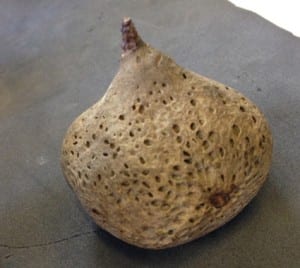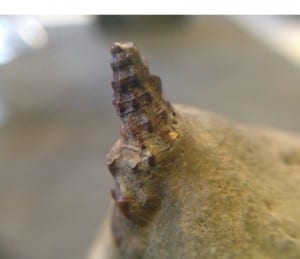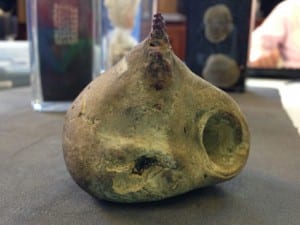Mystery Blob Sponge: It crawls! It creeps! It eats you alive!
By ucwaemo, on 14 October 2014
Day four of my sponge exploration (I’m here for ten months as the Museum’s Artist in Residence). There’s one specimen on the shelf that I’ve been saving as a particularly special treat… it looks like an onion, it’s not sealed in a jar, and it doesn’t have a label. It’s in the glass sponge cabinet, but it doesn’t look like the other specimens. Instead, it has a grey doughy appearance, covered in small holes, and it tapers at the top into a dark red spiral. I take it back to my desk for a closer look.
One of the (many) great things about spending time in the Grant Museum is that I share a room with people who not only know a lot about zoology, but also want to keep finding out more. I like to distract them from their work with questions like, ‘How do things, erm, grow?’. They are very patient. But today, I had a new question: ‘What is this oniony pointy sponge that has no label?’ Was it, perhaps, the broken base of a glass rope sponge? No – a glass sponge is too thready. Was it a fossil? No – a fossil would be heavier. Then we had a closer look at its pointy top:
It looked very much like the shell of a marine snail – had it perhaps become attached to the sponge? And then we looked at the whole object:
On the right is a large hole that disappears into a curve, the shape is regular, and there’s a tapered whirl of shell at the top. This mystery object is not one but two things – it’s a gastropod that has been encrusted with a sponge.
And over to Grant Museum Manager, Jack Ashby
When Eleanor showed me this blog post my own reaction was that the way the sponge had enveloped the snail was like the 1958 B-movie monster The Blob (It Crawls! It Creeps! It Eats You Alive!”). But then I thought that the animal inside the shell must have lived through the ordeal as the hole for the snail’s foot was open. The obvious contenders for shell-tenant are the snail itself or a hermit crab.
On closer inspection the sponge has oozed inside the mouth of the shell with a thin coating, which would rule out the snail being inside at the time as its body would have been attached to the shell’s opening.
On even closer inspection (I wish we had an endoscope), I could actually see that the hermit crab is still inside this specimen. It’s a crustacean encrustation. While the hermit crab would have to carry the extra weight and drag of the sponge, it would benefit from the extra protection and camouflage it offered. Take a look:
This sort of discovery is one of the many brilliant things that comes with people like artists coming in to study underused collections in close detail, with different eyes.
So this specimen actually made up of three separate phyla. The Mystery of the Sponge is solved, but it’s difficult to know what cabinet it should now live in.
Eleanor Morgan is Artist in Residence at the Grant Museum of Zoology
Jack Ashby is Manager of the Grant Museum of Zoology
5 Responses to “Mystery Blob Sponge: It crawls! It creeps! It eats you alive!”
- 1
-
2
Liz Hide wrote on 14 October 2014:
just trying to work out which bit the hermit crab is in – are you seeing it in the ‘large hole that disappears into a curve’?
how cosy it must all have been
- 3
-
4
Liz Hide wrote on 14 October 2014:
so the overall shape of the specimen reflects, roughly, the gastropod’s shape? ie it’s an overall blanket of sponge, rather than a gnarly carbuncle?
Halichondrid? or is Mark suggesting bryozoan? -
5
Jack Ashby wrote on 14 October 2014:

Looking at it, the snail starts as a very narrow turret but must widen rapidly and become more rounded as it gets to the bottom, given the size and position of the opening.
The blanket is still pretty thick, bordering on carbuncle.
Chances are it is some kind of Demosponge (not really narrowing it down), but we haven’t yet ruled out a calcareous sponge, or as Mark says, a bryozoan.
 Close
Close






Taphonomically, you could work out the order of events, if the sponge (or bryolith?) is particularly worn around the bottom then this shell was encrusted whilst the hermit crab was dragging it around.
I have fond memories of looking as fossil gastropod shells during my undergraduate degree and reconstructing the story of these little ecosystems from the position of encrusting organisms.